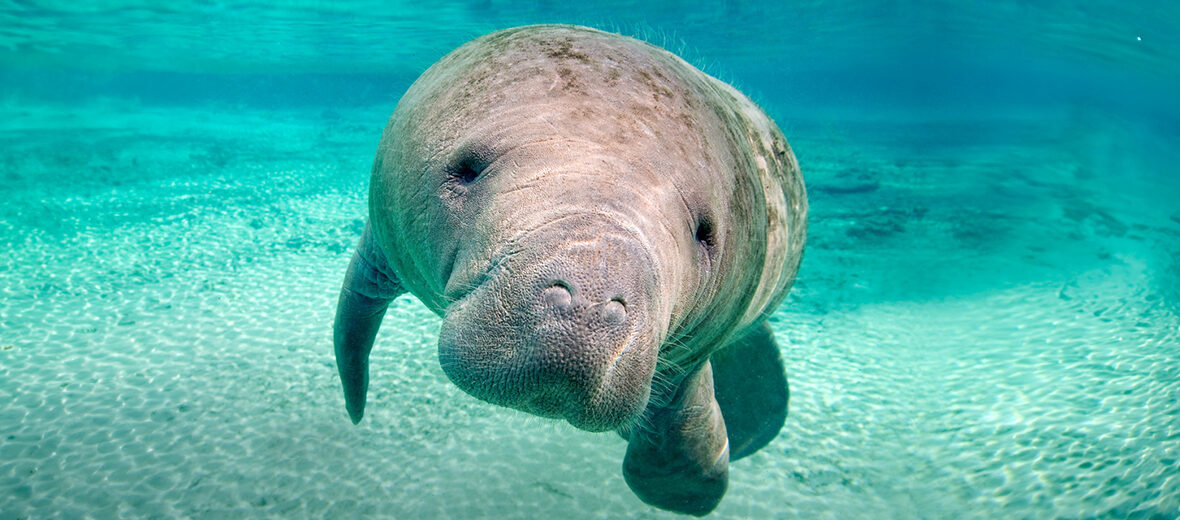
The West Indian manatee, aka North American manatee, is found among the warmer coastal areas of the Caribbean, from the eastern United States down to northern Brazil. Sadly, these amazing critters face the threats of habitat loss and destruction at the hands of residential and commercial developments; recreational activities that can result in vehicle strike, being hit by vehicles and propellers; and pollution. The IUCN lists these beautiful creatures as Vulnerable. Their numbers are also decreasing.
First the Stats…
Scientific name: Trichechus manatus
Weight: Up to 1,320 lbs.
Length: Up to 11.5 feet
Lifespan: Up to 60 years
Now on to the Facts!
1.) They are divided into 2 subspecies, the Antillean manatee in the Caribbean and the Florida manatee in the United States.
2.) Manatees are herbivorous (eat plant matter) and feed on various aquatic plants such as cordgrass, turtle grass, eelgrass, and even non-native hydrilla and water hyacinth. They also eat each other’s feces in order to obtain information about one another.
3.) Evolving in an environment lacking in predators, they have lost their predator avoidance behavior.
4.) These creatures have a slow metabolic rate and are thus capable of long dives before having to surface for air, topping out at 20 minutes per dive.
5.) When sleeping, which can last up to 12 hours a day, they have to surface every 20 minutes to breathe.
But wait, there’s more on the West Indian manatee!
6.) While typically solitary, these manatees do gather into breeding herds during the mating season.
7.) American Alligators, American crocodiles, bull sharks, and tiger sharks are their only predators, and their attacks are rare at best.
Did you know…?
West Indian manatees also engage in the Lombard effect just like humans. This is where they will involuntary increase their vocal efforts when communicating in loud environments.
8.) Communication consists of body language and vocalizations.
9.) Based on acoustical and anatomical findings, mammalian vocal folds are presumed to be the reason for sound production capabilities in manatees.
10.) Unlike other hindgut fermenters, like horses, manatees efficiently obtain nutrients, mostly cellulose, from the aquatic plants they consume.
But wait, there’s still more on the West Indian manatee!
11.) Their gastrointestinal tract measures up to 23% of their total body mass.
12.) It takes up to 7 days to pass food.
Did you know…?
Research has determined that manatees are able to use their vibrissae (whiskers) to detect hydrodynamic stimuli just like how fish use their lateral line system.
13.) Manatees are covered with sensitive tactile hairs that run the length of their bodies and faces called whiskers or vibrissae.
14.) Each individual hair is a vibrissal apparatus called a follicle-sinus complex. The vibrissae are blood filled sinuses bound by a thick connective tissue capsule that has sensitive nerve endings which provide haptic feedback to the manatee.
15.) Their mouths have highly mobile prehensile lips used to grab onto aquatic vegetation.
But wait, there’s still a little more on the West Indian manatee!
16.) Breeding takes place in ephemeral mating herds, where numerous males gather around an estrous (in heat) female to compete for access to her.
17.) Mating herds stay gathered for up to 4 weeks.
Did you know…?
Over 20% of manatee deaths per year are due to watercraft collisions. Between 1985 – 2017, 53% of adult-manatee deaths were due to boat strikes. 96% of adult Florida manatee carcasses have substantial scaring from boat collisions with some individuals showing signs of 10 or more boat strikes.
18.) Females undergo up to a 14 month gestation (pregnancy) that yields a single calf. Sometimes twins are born.
19.) Calves can weigh up to 75 lbs. and measure up to 4.5 feet long.
20.) Weaning is complete in up to 2 years.
But wait, there’s still a bit more on the West Indian manatee!
21.) Natural warm-water springs are faced with issues from over-pumping of groundwater for human consumption, reduced spring flow, and excess nutrient pollution.
22.) Also, some springs that were once accessible to manatees are now blocked off by dams or other structures.
23.) Dangerous algae blooms are also a threat to manatees. Red tide is a common name for algal blooms that get their telltale coloration from pigmentation molecules within the algae. The blooms create brevetoxins which are potentially fatal to marine life.
24.) Most manatee fatalities from red tide happen when manatees inhale the toxins, or consume the toxins when grazing on seagrass, their main food source. During a 1996 epizootic an estimated 150+ manatees died from red tide exposure.
Now a Short West Indian Manatee Video!
Be sure to share & comment below! Also, check out the Critter Science YouTube channel. Videos added regularly!
Want to suggest a critter for me to write about? Let me know here.
Some source material acquired from: Wikipedia & IUCN
Photo credit: iNaturalist




